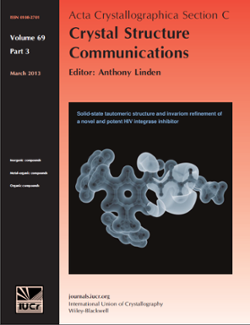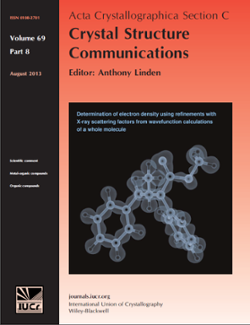Journal Covers
 HIV-1 integrase catalyzes the integration of viral DNA into human chromosomal DNA (the point of no return in an HIV infection). The conformation and tautomeric structure of a potent and novel integrase inhibitor with potential for HIV/AIDS therapeutics was determined by the Center. The electrostatic potential of this molecule was derived from the electron density and provides information of this molecule's ability to inhibit the activity of the integrase. This research, in conjunction with the University of Georgia Center for Drug Discovery led by Professor Vasu Nair, has been highlighted and selected for the front cover of Acta Crystallographica Section C for March 2013.
HIV-1 integrase catalyzes the integration of viral DNA into human chromosomal DNA (the point of no return in an HIV infection). The conformation and tautomeric structure of a potent and novel integrase inhibitor with potential for HIV/AIDS therapeutics was determined by the Center. The electrostatic potential of this molecule was derived from the electron density and provides information of this molecule's ability to inhibit the activity of the integrase. This research, in conjunction with the University of Georgia Center for Drug Discovery led by Professor Vasu Nair, has been highlighted and selected for the front cover of Acta Crystallographica Section C for March 2013.

We have determined the electron density in a 1,3-diphenylcyclopropanecarboxylate molecule by refining single-crystal X-ray data using scattering factors derived from quantum mechanical calculations. The C-C bonds are expected to be weakened by strain. However, the characteristic C-C bond length in cyclopropane is 1.50 Å and is shorter than the normal C-C bond length of 1.54 Å. In this cyclopropane, the ring does not have C3 symmetry but has two long C-C bonds (1.5421 (4) and 1.5338 (4) Å) and one short bond (1.5019 (4) Å). The shortest C-C bond occurs between the hydrido substituted C atoms distal to the formate group. Topological analysis of the three cyclopropane C-C bonds were carried out. The electron densities in the cyclopropane ring and the effects of the substitution on the C-C bonds are described. This research, in conjunction with Professor Huw Davies and the Cherry L. Emerson Center for Scientific Computation at Emory has been selected for the front cover of Acta Crystallographica Section C for August 2013.

